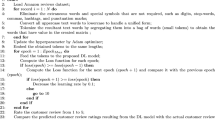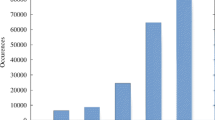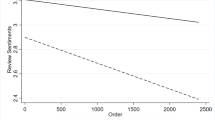Abstract
Online consumer reviews and ratings are two important paradigms of any e-commerce business. Based on the posted reviews and ratings, customers decide the product’s reliability and make their purchase decisions. Usually, reviews and ratings come together. In a review, the user writes all the pros and cons of the product, whereas the rating is a cumulative representation of the review text given on a scale of 1–5. If any review is positive, its associated ratings are 4 and 5, and if the review is negative, it comes with ratings 1 and 2. Sometimes, the rating does not represent the review text correctly, for example, a negative review gives a rating 4 or 5, or positive review gives a rating 1 or 2. This creates an inconsistency between reviews and ratings. This paper develops a machine learning-based model for identifying such inconsistency and prompting users for their posts. A Long Short-Term Memory-based model is developed to classify each review into either positive or negative polarity. The predicted polarity is then checked with the user’s rating for consistency.
Access this chapter
Tax calculation will be finalised at checkout
Purchases are for personal use only
Similar content being viewed by others
References
Saumya, S., & Singh, J. P. (2018). Detection of spam reviews: a sentiment analysis approach. CSI Transactions on ICT, 6, 137–148.
Saini, S., Saumya, S., & Singh, J. P. (2017). Sequential purchase recommendation system for e-commerce sites. In IFIP International Conference on Computer Information Systems and Industrial Management (pp. 366–375). Springer.
Singh, J. P., Irani, S., Rana, N. P., Dwivedi, Y. K., Saumya, S., & Roy, P. K. (2017). Predicting the helpfulness of online consumer reviews. Journal of Business Research, 70, 346–355.
Saumya, S., Singh, J. P., & Dwivedi, Y. K. (2019). Predicting the helpfulness score of online reviews using convolutional neural network. Soft Computing, 1–17.
Qazi, A., Syed, K. B. S., Raj, R. G., Cambria, E., Tahir, M., & Alghazzawi, D. (2016). A concept-level approach to the analysis of online review helpfulness. Computers in Human Behavior, 58, 75–81.
Krishnamoorthy, S. (2015). Linguistic features for review helpfulness prediction. Expert Systems with Applications, 42(7), 3751–3759.
Allahbakhsh, M., Ignjatovic, A., Motahari-Nezhad, H. R., & Benatallah, B. (2015). Robust evaluation of products and reviewers in social rating systems. World Wide Web, 18(1), 73–109.
Chua, A. Y., & Banerjee, S. (2016). Helpfulness of user-generated reviews as a function of review sentiment, product type and information quality. Computers in Human Behavior, 54, 547–554.
BrightLocal (2017). Local consumer review survey. Retrieved December 22, from www.brightlocal.com/learn/localconsumer-review-survey/.
Saumya, S., Singh, J. P., Baabdullah, A. M., Rana, N. P., & Dwivedi, Y. K. (2018). Ranking online consumer reviews. Electronic Commerce Research and Applications, 29, 78–89.
Mudambi, S. M., & D. Schuff (2010). What makes a helpful review? a study of customer reviews on amazon.com. MIS Quarterly, 34(1), 185–200.
Saumya, S., Singh, J. P., & Kumar, P. (2016). Predicting stock movements using social network. In Conference on e-Business, e-Services and e-Society (pp. 567–572). Springer.
Hochreiter, S., & Schmidhuber, J. (1997). Long short-term memory. Neural Computation, 9(8), 1735–1780.
Kingma, D. P., & Ba, J. (2014). Adam: A method for stochastic optimization. arXiv:1412.6980.
Hecht-Nielsen, R. (1992). Theory of the backpropagation neural network. In Neural networks for perception (pp. 65–93). Academic Press.
Lee, S., & Choeh, J. Y. (2014). Predicting the helpfulness of online reviews using multilayer perceptron neural networks. Expert Systems with Applications, 41(6), 3041–3046.
Liu, B. (2012). Sentiment analysis and opinion mining. Synthesis lectures on human language technologies, 5(1), 1–167.
Author information
Authors and Affiliations
Corresponding author
Editor information
Editors and Affiliations
Rights and permissions
Copyright information
© 2021 Springer Nature Singapore Pte Ltd.
About this paper
Cite this paper
Saumya, S., Singh, J.P., Kumar, A. (2021). A Machine Learning Model for Review Rating Inconsistency in E-commerce Websites. In: Sharma, N., Chakrabarti, A., Balas, V., Martinovic, J. (eds) Data Management, Analytics and Innovation. Advances in Intelligent Systems and Computing, vol 1174. Springer, Singapore. https://doi.org/10.1007/978-981-15-5616-6_16
Download citation
DOI: https://doi.org/10.1007/978-981-15-5616-6_16
Published:
Publisher Name: Springer, Singapore
Print ISBN: 978-981-15-5615-9
Online ISBN: 978-981-15-5616-6
eBook Packages: Intelligent Technologies and RoboticsIntelligent Technologies and Robotics (R0)




